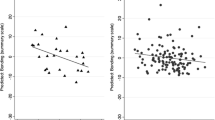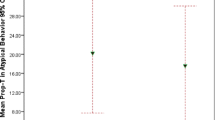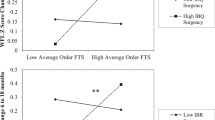Abstract
This study investigates the temporal patterning of infant self-regulatory behaviors (crying/fussing, sleeping) in relation to both infant (age, sex, regulatory problems) and maternal variables (soothing behaviors, mood). Self-regulatory and soothing behaviors were assessed in 121 mother-infant dyads (4–44 weeks) by the Baby’s Day Diary at 5 min intervals over 3 days. Further infant characteristics and maternal mood were assessed by questionnaires (DASS, CES-D, STAI) and the Diagnostic Interview for the Assessment of Regulatory Problems in Infancy and Toddlerhood. Data were analyzed using generalized additive mixed models. Negative maternal mood was associated with a deviant course of crying/fussing during the day. Body contact was associated with reduced variability in the 24 h course of sleep. Mother-infant transactional processes—above and beyond known relationships with overall levels of crying/fussing and sleeping—might play out on the temporal dimension of infant regulatory behaviors.


Similar content being viewed by others
References
Eisenberg N, Spinrad TL (2004) Emotion-related regulation: sharpening the definition. Child Dev 75:333–339
Papousek M, von Hofacker N (1998) Persistent crying in early infancy: a non-trivial condition of risk for the developing mother-infant relationship. Child Care Health Dev 24:395–424
Williams KE, Nicholson JM, Walker S, Berthelsen D (2016) Early childhood profiles of sleep problems and self-regulation predict later school adjustment. Br J Educ Psychol 86:331–350
Posner MI, Rothbart MK (2000) Developing mechanisms of self-regulation. Dev Psychopathol 12:427–441
Zero To Three (2005) DC:0-3R: diagnostic classification of mental health and developmental disorders in infancy and early childhood (rev.). Zero to Three Press, Washington, DC
Deutsche Gesellschaft für Kinder- und Jugendpsychiatrie und Psychotherapie (2007) Leitlinien zu Diagnostik und Therapie von psychischen Störungen im Säuglings-, Kindes- und Jugendalter. 3. Auflage: Deutscher Ärzte Verlag
Papousek M, Schieche M, Wurmser H (2008) Disorders of behavioral and emotional regulation in the first years of life: early risk and intervention in the developing parent-infant relationship, 1 edn. Zero to Three, Washington, DC
Schmid G, Schreier A, Meyer R, Wolke D (2010) A prospective study on the persistence of infant crying, sleeping and feeding problems and preschool behaviour. Acta Paediatr 99:286–290
Reijneveld SA, Brugman E, Hirasing RA (2001) Excessive infant crying: the impact of varying definitions. Pediatrics 108:893–897
Richter N, Reck C (2013) Positive maternal interaction behavior moderates the relation between maternal anxiety and infant regulatory problems. Infant Behav Dev 36:498–506
Wolke D, Meyer R, Orth B, Riegel K (1995) Co-morbidity of crying and feeding problems with sleeping problems in infancy: concurrent and predictive associations. Early Dev Parent 4:191–207
Briggs-Gowan MJ, Carter AS, Bosson-Heenan J, Guyer AE, Horwitz SM (2006) Are infant-toddler social-emotional and behavioral problems transient? J Am Acad Child Adolesc Psychiatr 45:849–858
Wolke D, Rizzo P, Woods S (2002) Persistent infant crying and hyperactivity problems in middle childhood. Pediatrics 109:1054–1060
Sadeh A, Tikotzky L, Kahn M (2014) Sleep in infancy and childhood: implications for emotional and behavioral difficulties in adolescence and beyond. Curr Opin Psychiatr 27:453–459
Sadeh A, De Marcas G, Guri Y, Berger A, Tikotzky L, Bar-Haim Y (2015) Infant sleep predicts attention regulation and behavior problems at 3–4 years of age. Dev Neuropsychol 40:122–137
Goodlin-Jones BL, Burnham MM, Gaylor EE, Anders TF (2001) Night waking, sleep-wake organization, and self-soothing in the first year of life. J Dev Behav Pediatr 22:226–233
Mirmiran M, Maas YGH, Ariagno RL (2003) Development of fetal and neonatal sleep and circadian rhythms. Sleep Med Rev 7:321–334
Henderson JT, France KG, Owens JL, Blampied NM (2010) Sleeping through the night: the consolidation of self-regulated sleep across the first year of life. Pediatrics 126:1081–1087
Weinraub M, Bender RH, Friedman SL, Susman EJ, Knoke B, Bradley R et al (2012) Patterns of developmental change in infants’ nighttime sleep awakenings from 6 through 36 months of age. Dev Psychol 48:1511–1528
Sadeh A, Anders TF (1993) Infant sleep problems: origins, assessment, interventions. Infant Ment Health J 14:17–34
Sadeh A, Tikotzky L, Scher A (2010) Parenting and infant sleep. Sleep Med Rev 14:89–96
St James-Roberts I, Conroy S, Wilsher K (1998) Links between maternal care and persistent infant crying in the early months. Child Care Health Dev 24:353–376
Leerkes EM, Blankson AN, O’Brien M (2009) Differential effects of maternal sensitivity to infant distress and nondistress on social-emotional functioning. Child Dev 80:762–775
Hiscock H, Wake M (2001) Infant sleep problems and postnatal depression: a community-based study. Pediatrics 107:1317–1322
Maxted AE, Dickstein S, Miller-Loncar C, High P, Spritz B, Liu J et al (2005) Infant colic and maternal depression. Infant Ment Health J 26:56–68
Miller AR, Barr RG, Eaton WO (1993) Crying and motor behavior of six-week-old infants and postpartum maternal mood. Pediatrics 92:551–558
Philbrook LE, Teti DM (2016) Bidirectional associations between bedtime parenting and infant sleep: parenting quality, parenting practices, and their interaction. J Fam Psychol 30:431–441
van den Boom DC (1994) The influence of temperament and mothering on attachment and exploration: An experimental manipulation of sensitive responsiveness among lower-class mothers with irritable infants. Child Dev 65:1457–1477
St James-Roberts I, Alvarez M, Csipke E, Abramsky T, Goodwin J, Sorgenfrei E (2006) Infant crying and sleeping in London, Copenhagen and when parents adopt a “proximal” form of care. Pediatrics 117:1146–1155
McGlaughlin A, Grayson A (1999) A prospective study of crying during the first year of infancy. J Reprod Infant Psychol 17:41–52
St James-Roberts I, Plewis I (1996) Individual differences, daily fluctuations, and developmental changes in amounts of infant waking, fussing, crying, feeding, and sleeping. Child Dev 67:2527–2540
Weinberg MK, Tronick EZ, Cohn JF, Olson KL (1999) Gender differences in emotional expressivity and self-regulation during early infancy. Dev Psychol 35:175–188
Davis KF, Parker KP, Montgomery GL (2004) Sleep in infants and young children: part one: normal sleep. J Pediatr Health Care 18:65–71
Müller S, Hemmi MH, Wilhelm FH, Barr RG, Schneider S (2011) Parental report of infant sleep behavior by electronic versus paper-and-pencil diaries, and their relationship to actigraphic sleep measurement. J Sleep Res 20:598–605
Hemmi MH, Schneider S, Müller S, Meyer AH, Wilhelm FH (2011) Analyzing temporal patterns of infant sleep and negative affective behavior: a comparison between different statistical models. Infant Behav Dev 34:541–551
Sinai D, Tikotzky L (2012) Infant sleep, parental sleep and parenting stress in families of mothers on maternity leave and in families of working mothers. Infant Behav Dev 35:179–186
Vaughn BE, Bradley CF, Joffe LS, Seifer R, Barglow P (1987) Maternal characteristics measured prenatally are predictive of ratings of temperamental “difficulty” on the Carey Infant Temperament Questionnaire. Dev Psychol 23:152–161
Sadeh A (1994) Assessment of intervention for infant night waking: parental reports and activity-based home monitoring. J Consult Clin Psychol 62:63–68
Sadeh A (1996) Evaluating night wakings in sleep-disturbed infants: a methodological study of parental reports and actigraphy. Sleep 19:757–762
So K, Adamson TM, Horne RSC (2007) The use of actigraphy for assessment of the development of sleep/wake patterns in infants during the first 12 months of life. J Sleep Res 16:181–187
Thomas KA, Burr RL (2009) Accurate assessment of mother & infant sleep: how many diary days are required? MCN Am J Matern Child Nurs 34:256–260
Barr RG, Kramer MS, Boisjoly C, McVey-White L, Pless IB (1988) Parental diary of infant cry and fuss behaviour. Arch Dis Child 63:380–387
Barr RG, Kramer MS, Pless IB, Boisjoly C, Leduc D (1989) Feeding and temperament as determinants of early infant crying/fussing behavior. Pediatrics 84:514–521
Hunziker UA, Barr RG (1986) Increased carrying reduces infant crying: a randomized controlled trial. Pediatrics 77:641–648
St James-Roberts I, Hurry J, Bowyer J (1993) Objective confirmation of crying durations in infants referred for excessive crying. Arch Dis Child 68:82–84
St James-Roberts I, Conroy S, Wilsher C (1998) Stability and outcome of persistent infant crying. Infant Behav Dev 21:411–435
Schneider S, Wolke D (2007) Diagnostisches Interview zur Erfassung von Regulationsstörungen im Säuglings- und Kleinkindalter (Baby-DIPS) [The diagnostic interview for the assessment of regulatory problems in infancy and toddlerhood]. University of Basel, CH
Popp L, Fuths S, Seehagen S, Bolten M, Gross-Hemmi M, Wolke D, Schneider S (2016) Inter-rater reliability and acceptance of the structured diagnostic interview for regulatory problems in infancy. Child Adolesc Psychiatr Ment Health 10:21
Lovibond SH, Lovibond PF (2004) Manual for the depression anxiety stress scales. Psychology Foundation Monograph, Sydney
Radloff LS (1977) The CES-D scale: a self-report depression scale for research in the general population. Appl Psychol Meas 3:385–401
Hautzinger M, Bailer M (1993) Allgemeine Depressions-Skala—ADS. Hogrefe, Göttingen
Laux L, Glanzmann P, Schaffner R, Spielberger CD (1982) The state-trait anxiety inventory. Beltz, Weinheim
Brown TA, Chorpita BF, Korotitsch W, Barlow DH (1997) Psychometric properties of the Depression Anxiety Stress Scales (DASS) in clinical samples. Behav Res Ther 35:79–89
Nilges P, Essau C (2015) Die Depressions-Angst-Stress-Skalen. Schmerz 29:649–657
Alexandrowicz RW, Jahn R, Wancata J (2018) Assessing the dimensionality of the CES-D using multi-dimensional multi-level Rasch models. PLoS ONE 13:e0197908
Van Dam NT, Earleywine M (2011) Validation of the Center for Epidemiologic Studies Depression Scale—Revised (CESD-R): Pragmatic depression assessment in the general population. Psychiatr Res 186:128–132
Ortuño-Sierra J, García-Velasco L, Inchausti F, Debbané M, Fonseca-Pedrero E (2016) New approaches on the study of the psychometric properties of the STAI. Actas Esp Psiquiatr 44:83–92
Wood SN (2006) Generalized Additive Models: An Introduction with R. Chapman & Hall/CRC Texts in Statistical Science, CRC Press, Boca Raton, US
Zuur AF, Ieno EN, Walker NJ, Saveliev AA, Smith GM (2009) Mixed Effects Models and Extensions in Ecology with R. Springer, Heidelberg
Guisan A, Edwards TC, Hastie T (2002) Generalized linear and generalized additive models in studies of species distributions: setting the scene. Ecol Model 157:89–100
R Development Core Team (2009) R: A language and environment for statistical computing. Foundation for Statistical Computing, Vienna
Bates D, Maechler M (2009) lme4: Linear mixed-effects models using S4 classes. R package version 0.999375-31: http://CRAN.R-project.org/package=lme4
Wood S (2009) gamm4: Generalized additive mixed models using mgcv and lme4. R package version 0.0–1: http://CRAN.R-project.org/package=gamm4
Wolke D, Bilgin A, Samara M (2017) Systematic review and meta-analysis: fussing and crying durations and prevalence of colic in infants. J Pediatr 185:55–61
Cassidy J (1994) Emotion regulation: Influences of attachment relationships. Monogr Soc Res Child Dev 59:228–249
Alvarez M (2004) Caregiving and early infant crying in a Danish community. J Dev Behav Pediatr 25:91–98
Murray L, Stanley C, Hooper R, King F, Fiori-Cowley A (1996) The role of infant factors in postnatal depression and mother-infant interactions. Dev Med Child Neurol 38:109–119
Waters SF, West TV, Mendes WB (2014) Physiological covariation between mothers and infants. Psychol Sci 25:934–942
Sadeh A, Juda-Hanael M, Livne-Karp E, Kahn M, Tikotzky L, Anders TF et al (2016) Low parental tolerance for infant crying: an underlying factor in infant sleep problems? J Sleep Res 25:501–507
Luijk MPCM, Mileva-Seitz VR, Jansen PW, van IJzendoorn MH, Jaddoe VWV, Raat H et al (2013) Ethnic differences in prevalence and determinants of mother–child bed-sharing in early childhood. Sleep Med 14:1092–1099
Volkovic E, Ben-Zion H, Karny D, Meiri G, Tikotzky L (2015) Sleep patterns of co-sleeping and solitary sleeping infants and mothers: a longitudinal study. Sleep Med 16:1305–1312
Shimizu M, Teti DM (2018) Infant sleeping arrangements, social criticism, and maternal distress in the first year. Inf Child Dev 27:e2080
Garrison MM, Christakis DA (2000) A systematic review of treatments for infant colic. Pediatrics 106(Suppl 1):184–190
Hauck FR, Signore C, Fein SB, Raju TNK (2008) Infant sleeping arrangements and practices during the first year of life. Pediatrics 122(Suppl 2):113–120
Morelli GA, Rogoff B, Oppenheim D, Goldsmith D (1992) Cultural variation in infants’ sleeping arrangements: questions of independence. Dev Psychol 28:604–613
Teti DM, Shimizu M, Crosby B, Kim B-R (2016) Sleep arrangements, parent–infant sleep during the first year, and family functioning. Dev Psychol 52:1169–1181
Mileva-Seitz VR, Bakermans-Kranenburg MJ, Battaini C, Luijk MPCM (2017) Parent-child bed-sharing: the good, the bad, and the burden of evidence. Sleep Med Rev 32:4–27
St James-Roberts I, Halil T (1991) Infant crying patterns in the first year: normal community and clinical findings. J Child Psychol Psychiatr 32:951–968
McGaughlin A, Grayson A (2001) Crying in the first year of infancy: patterns and prevalence. J Reprod Infant Psychol 19:47–59
Else-Quest NM, Hyde JS, Goldsmith HH, Van Hulle CA (2006) Gender differences in temperament: a meta-analysis. Psychol Bull 132:33–72
Mindell JA, Sadeh A, Kohyama J, How TH (2010) Parental behaviors and sleep outcomes in infants and toddlers: a cross-cultural comparison. Sleep Med 11:393–399
Barr RG, Konner M, Bakeman R, Adamson L (1991) Crying in !Kung San infants: a test of the cultural specificity hypothesis. Dev Med Child Neurol 33:601–610
Funding
This study is part of the National Centre of Competence in Research (NCCR) Swiss Etiological Study of Adjustment and Mental Health (sesam). The Swiss National Science Foundation (SNF) (project no. A240-104890), the University of Basel, the F. Hoffmann-La Roche Corp., and Basel Scientific Society provided core support for the NCCR sesam.
Author information
Authors and Affiliations
Corresponding author
Ethics declarations
Conflict of interest
The authors declare that they have no conflict of interest.
Ethical Approval
All procedures performed in this study were in accordance with the ethical standards of the Medical Ethics Committee of Basel (Switzerland) and with the 1964 Helsinki declaration and its later amendments or comparable ethical standards.
Informed Consent
Written informed consent was obtained from all participating mothers included in the study.
Additional information
Publisher’s Note
Springer Nature remains neutral with regard to jurisdictional claims in published maps and institutional affiliations.
Rights and permissions
About this article
Cite this article
Mohr, C., Gross-Hemmi, M.H., Meyer, A.H. et al. Temporal Patterns of Infant Regulatory Behaviors in Relation to Maternal Mood and Soothing Strategies. Child Psychiatry Hum Dev 50, 566–579 (2019). https://doi.org/10.1007/s10578-018-00862-5
Published:
Issue Date:
DOI: https://doi.org/10.1007/s10578-018-00862-5




